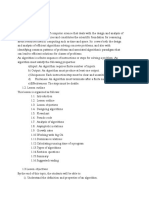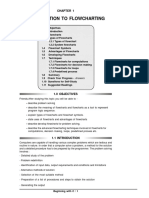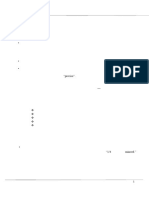0 ratings0% found this document useful (0 votes)
51 viewsLec.1 Algorithm & Flow Chart
The document discusses algorithms and flowcharts. It defines an algorithm as a sequence of steps to solve a problem using a computer. A flowchart is a graphical representation of an algorithm that shows the steps. The document gives examples of flowcharts symbols like terminator, process, decision, connector, and data. It also provides examples of algorithms for problems like finding the sum, average, and product of numbers, and determining the largest of two numbers. The key benefits of algorithms and flowcharts are efficiency, abstraction, and reusability in problem solving.
Uploaded by
هشام رعد ناجيCopyright
© © All Rights Reserved
Available Formats
Download as PDF, TXT or read online on Scribd
0 ratings0% found this document useful (0 votes)
51 viewsLec.1 Algorithm & Flow Chart
The document discusses algorithms and flowcharts. It defines an algorithm as a sequence of steps to solve a problem using a computer. A flowchart is a graphical representation of an algorithm that shows the steps. The document gives examples of flowcharts symbols like terminator, process, decision, connector, and data. It also provides examples of algorithms for problems like finding the sum, average, and product of numbers, and determining the largest of two numbers. The key benefits of algorithms and flowcharts are efficiency, abstraction, and reusability in problem solving.
Uploaded by
هشام رعد ناجيCopyright
© © All Rights Reserved
Available Formats
Download as PDF, TXT or read online on Scribd
You are on page 1/ 17
Ali Abdulsalam
Chemical & Petrochemical Engineering Dept.
Technical Engineering college - Basra
A computer is a useful tool for solving a great variety of
problems. To make a computer do anything (i.e. solve a
problem), you have to write a computer program. In a
computer program you tell a computer, step by step,
exactly what you want it to do. The computer then executes
the program, following each step mechanically, to
accomplish the end goal.
The sequence of steps to be performed in order to solve a
problem by the computer is known as an algorithm.
Flowchart is a graphical or symbolic representation of an
algorithm. It is the diagrammatic representation of the step-by-
step solution to a given problem.
Program Design consists of the steps a programmer should do
before they start coding the program in a specific language.
Proper program design helps other programmers to maintain
the program in the future.
Let us follow an example to help us understand the concept of
algorithm in a better way. Let’s say that you have a friend arriving at
the railway station, and your friend needs to get from the railway
station to your house. Here are three different ways (algorithms) that
you might give your friend for getting to your home.
All these three algorithms accomplish the same goal, but each algorithm
does it in a different way. Each algorithm also has a different cost and a
different travel time. Taking a taxi/auto-rickshaw, for example, is the fastest
way, but also the most expensive. Taking the bus is definitely less
expensive, but a whole lot slower. You choose the algorithm based on the
circumstances.
In computer programming, there are often many different algorithms to
accomplish any given task. Each algorithm has advantages and
disadvantages in different situations. Sorting is one place where a lot of
research has been done, because computers spend a lot of time sorting
lists.
Three reasons for using algorithms are efficiency, abstraction and
reusability.
- Efficiency: Certain types of problems, like sorting, occur often in
computing. Efficient algorithms must be used to solve such problems
considering the time and cost factor involved in each algorithm.
- Abstraction: Algorithms provide a level of abstraction in solving
problems because many seemingly complicated problems can be
distilled into simpler ones for which wellknown algorithms exist.
- Reusability: Algorithms are often reusable in many different
situations.
The benefits of flowcharts are as follows:
Communication: Flowcharts are better way of communicating the logic of a
system to all concerned.
Effective analysis: With the help of flowchart, problem can be analysed in more
effective way.
Proper documentation: Program flowcharts serve as a good program
documentation, which is needed for various purposes.
Efficient Coding: The flowcharts act as a guide or blueprint during the systems
analysis and program development phase.
Proper Debugging: The flowchart helps in debugging process.
Efficient Program Maintenance: The maintenance of operating program
becomes easy with the help of flowchart. It helps the programmer to put efforts
more efficiently on that part.
Although a flowchart is a very useful tool, there are a few limitations
in using flowcharts which are listed below:
Complex logic: Sometimes, the program logic is quite complicated.
In that case, flowchart becomes complex and clumsy.
Alterations and Modifications: If alterations are required the
flowchart may require re-drawing completely.
Reproduction: As the flowchart symbols cannot be typed,
reproduction of flowchart becomes a problem.
Terminator: An oval flow chart shape indicates the start or end of the process,
usually containing the word “Start” or “End”.
Process: A rectangular flow chart shape indicates a normal/generic process flow
step. For example, “Add 1 to X”, “M = M*F” or similar.
Decision: A diamond flow chart shape indicates a branch in the
process flow. This symbol is used when a decision needs to be made,
commonly a Yes/No question or True/False test.
Connector: A small, labelled, circular flow chart shape used to
indicate a jump in the process flow. Connectors are generally used in
complex or multi-sheet diagrams.
Data: A parallelogram that indicates data input or output (I/O) for a
process. Examples: Get X from the user, Display X.
Arrow: used to show the flow of control in a process. An arrow coming
from one symbol and ending at another symbol represents that
control passes to the symbol the arrow points to.
example, consider that we need to find the sum, average and product
of 3 numbers given by the user.
Write (Display) the Sum, Average and Product :
1 – by draw flow chart
2 - by write an algorithm ( H.W)
Consider another problem of finding the largest number between A and B
Algorithm for the above problem is as follows:
Read A, B
If A is less than B
BIG=B
SMALL = A
Else
BIG=A
SMALL = B
Write (Display) BIG, SMALL
“INTRODUCTION TO C++”, INSTITUTE OF DISTANCE & OPEN LEARNING, Unit
One
You might also like
- Continental Diesel Engine Reference Guide: Make Fits Application Engine Details0% (1)Continental Diesel Engine Reference Guide: Make Fits Application Engine Details1 page
- Institute - Uie Department-Academic Unit-2No ratings yetInstitute - Uie Department-Academic Unit-227 pages
- Algorithm and Flowchart: Computer Programming (Object Oriented Programming)No ratings yetAlgorithm and Flowchart: Computer Programming (Object Oriented Programming)31 pages
- New 05-Algorithm Design and Problem SolvingNo ratings yetNew 05-Algorithm Design and Problem Solving41 pages
- GE8151 Problem Solving and Python Programming - 03 - by LearnEngineering - inNo ratings yetGE8151 Problem Solving and Python Programming - 03 - by LearnEngineering - in100 pages
- FPL Notes 2024 Pattern by Imp Solution Hub_250107_164337No ratings yetFPL Notes 2024 Pattern by Imp Solution Hub_250107_164337170 pages
- CSC 1102: Programming Language 1 Flow Charts: Sarwar Morshed American International UniversityNo ratings yetCSC 1102: Programming Language 1 Flow Charts: Sarwar Morshed American International University45 pages
- Lesson 5 - Lecture in Algorithm and Flowcharting: Introduction To Programming Languages0% (1)Lesson 5 - Lecture in Algorithm and Flowcharting: Introduction To Programming Languages46 pages
- Algorithm and Flowchart: B. Properties of AlgorithmNo ratings yetAlgorithm and Flowchart: B. Properties of Algorithm28 pages
- Introduction To Flowcharting: Programming ProcessNo ratings yetIntroduction To Flowcharting: Programming Process3 pages
- Lecture 1_B_Algorithms-and-Flowchart_TutorialNo ratings yetLecture 1_B_Algorithms-and-Flowchart_Tutorial26 pages
- Pps Unit 1 Lesson Algorithms and FlowchartsNo ratings yetPps Unit 1 Lesson Algorithms and Flowcharts17 pages
- Chapter 1-Introduction To Algorithms and Flowchart100% (1)Chapter 1-Introduction To Algorithms and Flowchart16 pages
- Saarthi Education Jija Mata Colony, Near Paithan Gate A Bad. Cont: 8694947070 / 5050No ratings yetSaarthi Education Jija Mata Colony, Near Paithan Gate A Bad. Cont: 8694947070 / 50508 pages
- Keto Chocolate Mousse (3 Ingredients) - The Big Man's World ®No ratings yetKeto Chocolate Mousse (3 Ingredients) - The Big Man's World ®1 page
- Versatile, Feature-Rich Production Routing!: Multicam 3000 Series CNC Router Feature and Specification GuideNo ratings yetVersatile, Feature-Rich Production Routing!: Multicam 3000 Series CNC Router Feature and Specification Guide7 pages
- WEF Facilitating Global Interoperability Cyber Regulations 2023No ratings yetWEF Facilitating Global Interoperability Cyber Regulations 202312 pages
- Air Pollution Prediction System For Smart CityNo ratings yetAir Pollution Prediction System For Smart City3 pages
- The Institution of Engineers BangladeshiebNo ratings yetThe Institution of Engineers Bangladeshieb105 pages
- Quantum Speed Reading As A Quasi Telepathic Commun100% (4)Quantum Speed Reading As A Quasi Telepathic Commun26 pages
- Financial Analysis of Household Photovoltaic Self-Consumption in The Context of The Vehicle-to-Home (V2H) in PortugalNo ratings yetFinancial Analysis of Household Photovoltaic Self-Consumption in The Context of The Vehicle-to-Home (V2H) in Portugal21 pages
- Every Letter I Write Is Not A Love Letter': Ina BlomNo ratings yetEvery Letter I Write Is Not A Love Letter': Ina Blom10 pages
- On Characterizations of NANO RGB-Closed Sets in NANO Topological SpacesNo ratings yetOn Characterizations of NANO RGB-Closed Sets in NANO Topological Spaces9 pages
- Continental Diesel Engine Reference Guide: Make Fits Application Engine DetailsContinental Diesel Engine Reference Guide: Make Fits Application Engine Details
- Algorithm and Flowchart: Computer Programming (Object Oriented Programming)Algorithm and Flowchart: Computer Programming (Object Oriented Programming)
- GE8151 Problem Solving and Python Programming - 03 - by LearnEngineering - inGE8151 Problem Solving and Python Programming - 03 - by LearnEngineering - in
- FPL Notes 2024 Pattern by Imp Solution Hub_250107_164337FPL Notes 2024 Pattern by Imp Solution Hub_250107_164337
- CSC 1102: Programming Language 1 Flow Charts: Sarwar Morshed American International UniversityCSC 1102: Programming Language 1 Flow Charts: Sarwar Morshed American International University
- Lesson 5 - Lecture in Algorithm and Flowcharting: Introduction To Programming LanguagesLesson 5 - Lecture in Algorithm and Flowcharting: Introduction To Programming Languages
- Algorithm and Flowchart: B. Properties of AlgorithmAlgorithm and Flowchart: B. Properties of Algorithm
- Chapter 1-Introduction To Algorithms and FlowchartChapter 1-Introduction To Algorithms and Flowchart
- Computer Algebra: Fundamentals and ApplicationsFrom EverandComputer Algebra: Fundamentals and Applications
- Saarthi Education Jija Mata Colony, Near Paithan Gate A Bad. Cont: 8694947070 / 5050Saarthi Education Jija Mata Colony, Near Paithan Gate A Bad. Cont: 8694947070 / 5050
- Keto Chocolate Mousse (3 Ingredients) - The Big Man's World ®Keto Chocolate Mousse (3 Ingredients) - The Big Man's World ®
- Versatile, Feature-Rich Production Routing!: Multicam 3000 Series CNC Router Feature and Specification GuideVersatile, Feature-Rich Production Routing!: Multicam 3000 Series CNC Router Feature and Specification Guide
- WEF Facilitating Global Interoperability Cyber Regulations 2023WEF Facilitating Global Interoperability Cyber Regulations 2023
- Quantum Speed Reading As A Quasi Telepathic CommunQuantum Speed Reading As A Quasi Telepathic Commun
- Financial Analysis of Household Photovoltaic Self-Consumption in The Context of The Vehicle-to-Home (V2H) in PortugalFinancial Analysis of Household Photovoltaic Self-Consumption in The Context of The Vehicle-to-Home (V2H) in Portugal
- Every Letter I Write Is Not A Love Letter': Ina BlomEvery Letter I Write Is Not A Love Letter': Ina Blom
- On Characterizations of NANO RGB-Closed Sets in NANO Topological SpacesOn Characterizations of NANO RGB-Closed Sets in NANO Topological Spaces

























































































